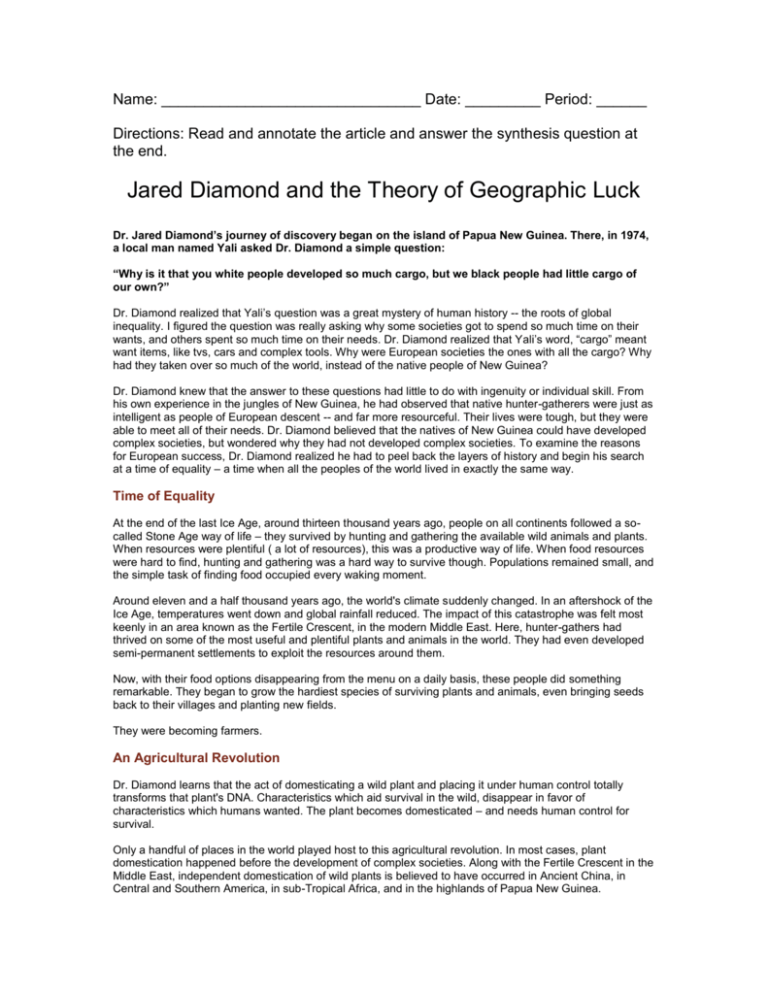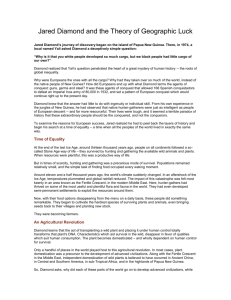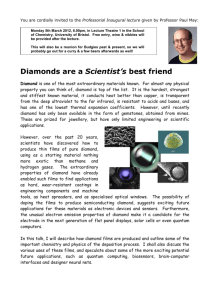Jared Diamond and the Theory of Geographic Luck
advertisement

Name: _______________________________ Date: _________ Period: ______ Directions: Read and annotate the article and answer the synthesis question at the end. Jared Diamond and the Theory of Geographic Luck Dr. Jared Diamond’s journey of discovery began on the island of Papua New Guinea. There, in 1974, a local man named Yali asked Dr. Diamond a simple question: “Why is it that you white people developed so much cargo, but we black people had little cargo of our own?” Dr. Diamond realized that Yali’s question was a great mystery of human history -- the roots of global inequality. I figured the question was really asking why some societies got to spend so much time on their wants, and others spent so much time on their needs. Dr. Diamond realized that Yali’s word, “cargo” meant want items, like tvs, cars and complex tools. Why were European societies the ones with all the cargo? Why had they taken over so much of the world, instead of the native people of New Guinea? Dr. Diamond knew that the answer to these questions had little to do with ingenuity or individual skill. From his own experience in the jungles of New Guinea, he had observed that native hunter-gatherers were just as intelligent as people of European descent -- and far more resourceful. Their lives were tough, but they were able to meet all of their needs. Dr. Diamond believed that the natives of New Guinea could have developed complex societies, but wondered why they had not developed complex societies. To examine the reasons for European success, Dr. Diamond realized he had to peel back the layers of history and begin his search at a time of equality – a time when all the peoples of the world lived in exactly the same way. Time of Equality At the end of the last Ice Age, around thirteen thousand years ago, people on all continents followed a socalled Stone Age way of life – they survived by hunting and gathering the available wild animals and plants. When resources were plentiful ( a lot of resources), this was a productive way of life. When food resources were hard to find, hunting and gathering was a hard way to survive though. Populations remained small, and the simple task of finding food occupied every waking moment. Around eleven and a half thousand years ago, the world's climate suddenly changed. In an aftershock of the Ice Age, temperatures went down and global rainfall reduced. The impact of this catastrophe was felt most keenly in an area known as the Fertile Crescent, in the modern Middle East. Here, hunter-gathers had thrived on some of the most useful and plentiful plants and animals in the world. They had even developed semi-permanent settlements to exploit the resources around them. Now, with their food options disappearing from the menu on a daily basis, these people did something remarkable. They began to grow the hardiest species of surviving plants and animals, even bringing seeds back to their villages and planting new fields. They were becoming farmers. An Agricultural Revolution Dr. Diamond learns that the act of domesticating a wild plant and placing it under human control totally transforms that plant's DNA. Characteristics which aid survival in the wild, disappear in favor of characteristics which humans wanted. The plant becomes domesticated – and needs human control for survival. Only a handful of places in the world played host to this agricultural revolution. In most cases, plant domestication happened before the development of complex societies. Along with the Fertile Crescent in the Middle East, independent domestication of wild plants is believed to have occurred in Ancient China, in Central and Southern America, in sub-Tropical Africa, and in the highlands of Papua New Guinea. So, Dr. Diamond asks, why did each of these parts of the world go on to develop advanced civilizations, while the farmers of New Guinea were apparently left behind? The luck of the draw Dr. Diamond discovers that the answer lies in a geographical luck of the draw. His hypothesis was that where you live will really determine how successful your society will be. What mattered were the plants, animals soil and water of an area. Of all the plant species in the world, only a limited number are possible, or useful, to domesticate. Dr. Diamond's research discovered that most of these species are native to Europe and Asia – species like wheat, barley and rice, which grew wild in abundance in only these parts of the world. Two more species are native to Tropical Africa (sorghum and yams) while only one is native to the Americas (corn), and to Papua New Guinea (taro). Not a single domesticable plant grows wild in Australia. Dr. Diamond discovers a similar dramatic inequality in where the domesticable animals lived also. Animals increase the productivity of farming. The animals can do a lot of the hard work and provide their meat, milk, leather, dung (for fertilizer to help the plants grow), and as beasts of burden. Without them, farmers are trapped in a cycle of subsistence and manual labor. The groups that did not have animals, had to work harder than the animal societies and got less food when they went to harvest their crops. Of all the animal species in the world, only 14 have ever been domesticated. 12 of these are native to Eurasia. One, the llama, is native to South America – and the farmers of New Guinea managed to domesticate the pig. But pigs can't pull plows, and until the arrival of Europeans in the 20th century, all New Guinean farming was still done by hand. From tools to cities Dr. Diamond realized that the development of successful and productive farming, starting nearly 12,000 years ago in the Fertile Crescent, was the critical turning point in why Europeans developed complex societies that spent more time on their wants than on their needs. From this point on, one group of people – the natives of Eurasia – would have a head start on the path to having more cargo. Successful farming provides a food security, and allows some people to leave the farm behind and develop specialized skills – such as metal-working, writing, trade, politics, and war-making. Plus, the simple geography of the continent of Eurasia – one big landmass spread on an east-west axis, with universal latitudes and climates – allowed these technologies and ideas to spread beyond the Middle East with ease. Without the environment, or the time, to develop similar skills, the farmers of New Guinea became trapped in their highland isolation. Dr. Diamond concludes that from the end of the Ice Age, geography ensured that different societies around the world would develop at different speeds. If Yali's people had had all the geographic advantages of Europeans, perhaps they could have conquered the world. Epilogue Diamond believes the blueprint for global inequality lies within the land itself, its crops and animals. Synthesis: Do you agree or disagree with Jared Diamond’s theory of Geographic Luck? Explain your answer using evidence from the article and from the centers activity done in class.




